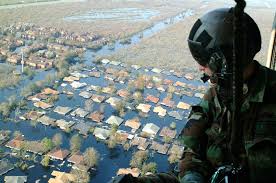by Bevan Ramsden

One quarter of a trillion dollars of tax- payers’ money is being spent on defending against an imaginary enemy but precious little is spent on preparing for and defending against the climate change enemy ravaging our communities.
We are all familiar with the frightening sight of walls of flames engulfing homes and the evacuation centres full of bushfire refugees who have fled for their lives whilst their properties are burned to the ground. For many, their livelihoods were also lost in the flames. And the climate change enemy struck again recently with huge downpours causing unprecedented flooding in the Australia’s eastern states. Again we gasped at the devastation. Homes under water up to gutter level; rescues from roof tops by helicopter; cars washed down the river and when the waters receded the heartbreaking clean up with some many possessions ruined and piled up in the street. And in both cases, many people faced with the awesome challenge of rebuilding their lives with so much lost to these climate disasters and so little to start back with.
It is not much different to the impact of wars on civilians as we have seen in Ukraine and indeed we should view these disasters in that light.
It is very instructive to compare the Government’s response to these events which are real and immediate, to their response to defending against an imaginary enemy which seems to be imbeded the minds of our leaders (both Liberal Coalition and the ALP) but shows no sign of materializing. It should be said however, that if such an enemy did materialize it will be entirely because of an abject subservience of that leadership to U.S. foreign policy and allowing that country to set up Australia as its Indo-Pacific military base for troops, aircraft and warships including nuclear submarines thus making us a target for enemies of the USA.
Projected spending on this imaginary enemy has reached a quarter of a trillion dollars. This is in addition to the annual recurrent expenditure on the ADF.
Included in this inventory is:
· Upgrade of Tindal Runway & fuel facilities to take U.S. B1 bombers & fighters $1.1 billion
· Upgrade to HMAS Stirling WA…………………………………………………………………………$1.0 billion
· Purchase of 135 of U.S. M-1A2C Abrams Tanks …………………………………………… $3.5 billion
· High Speed, long range, missile defence systems …………………………………………… $9.3 billion
· 30% increase in defence personnel up to 80,000 by 2040……………………………… $38.0 billion
· 8 x Nuclear submarines…………………………………………………………………………………… $70.0 billion but it is estimated that this will blow out to $171 billion (Michael Shoebridge of ASPI says more like $250 billion)
· Porting facilities for the nuclear submarines on the East Coast ……………………… $10.0 billion
· 72 x F35 fighter/bombers@ $140 million each ………………………………………………$10.0 billion
(will probably blow out )
· 9 x frigates ………………………………………………………………………………………………………$35.0 billion
(other estimates suggest this will blow out to $45 billion)
· Cost to Australia of 2,200 US Marines in Darwin each year unknown…………………………………?
(“I can’t tell you as it’s a national security matter” said the Defence Minister in answer to the question from IPAN)
TOTAL… $168 billion which if the blow out on nuclear subs and frigates is correct will end up $287 billion or over a quarter of a trillion dollars.
So what has been the response by government to defending the Australian communities from the ravages of the climate change enemy?
The Royal Commission into National Natural Disaster Arrangements was established on 20 February 2020 in response to the extreme bushfire season of 2019-20 which resulted in loss of life, property and wildlife and environmental destruction. One of Australia’s longest-serving fire chiefs, former commissioner of Fire & Rescue NSW Greg Mullins, says it is clear the Morrison Government has consistently failed to heed the advice of experts on climate change and the need for better preparation to respond to the growing threat of floods, droughts and bushfires. “Time and again this government fails to listen to expert advice. There are 80 recommendations of the Royal Commission into National Natural Disaster Arrangements gathering dust,” Mullins said.
The group of 37 former fire and emergency service chiefs issued a joint call under the Emergency Leaders for Climate Action collective, saying the Morrison government had been warned of the potential for major flooding events during 2022, but it failed to take any actions to prepare for their impacts. They say if the federal government had acted on the findings of the Royal Commission into Natural Disaster Arrangements called in the wake of the 2019-20 bushfire season, the flooded communities would have been better prepared. This would have meant more prepared first responders, reinforced critical infrastructure and stronger telecommunications networks, the group said.
Former Chief of the Defence Forces, Admiral Chris Barrie AC has stated: ”As ex-service members and experienced practitioners of national and international defence we recognise that climate change is a fundamental threat to all Australians. The first duty of Government must be the safety and security of its citizens”.
Instead, we find an Australian political leadership fixated on preparing for war with their UK and US, AUKUS partners with the projected spending of a quarter of a trillion of tax-payers’ dollars, whilst ignoring the very real and immediate climate enemy ravaging our communities.





